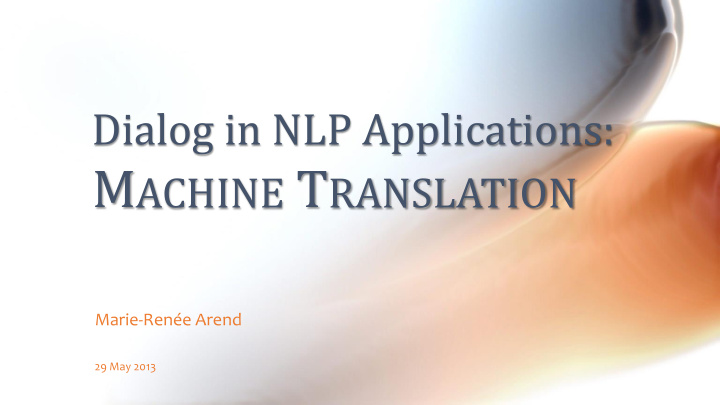



Dialog in NLP Applications: M ACHINE T RANSLATION Marie-Renée Arend 29 May 2013
Machine translation: Background info + terminology • Approaches to MT: • Direct • Transfer • Combined • Interlingua • Statistical • Automatic MT evaluation: • Common measure is BLEU score • Formula, if you really want to see it, is on p 897 in J&M 2 nd ed Source: http://www.123rf.com/
Issues for S2S translation systems • Translation of spontaneous dialog • Speaker independence and/or user adaptability • Latency • Context sensitivity • Improvement of communication “abilities” of system as a whole as opposed to independent module improvement • Evaluation: objective vs subjective
Verbmobil: what is it? • Speaker-independent, bidirectional S2S translation system for spontaneous mobile phone dialogs • German, English & Japanese • 3 business-oriented domains with specific foci and associated vocabulary • Context-sensitive translations • Hybrid system; incorporates both deep and shallow processing techniques • Integrates ML methods with linguists’ knowledge and rule -based methods
Verbmobil: data • Monolingual data: • Important feature of their speech corpus: multi- channel recording • Partitur format • Multilingual corpora: • Bilingual dialogs and aligned transliterations • 3 Treebanks developed for English/German/Japanese with 3 strata of annotations • 7 ML training methods
Verbmobil: main components • Language identification language • Recognizer modules • Prosody modules translation • Multi-engine parsing structure • 5 concurrent translation modules dialogue • Dialog component syntax • Transfer component • Semantic evaluation speech ch • Microplanning component & Syntactic realization module • Speech synthesis
Things to note • Non-sequential architecture • Info exchange between modules • “Blackboard” approach
Verbmobil: successes • Multi-engine approach • Able to have multiparty conversations/conferences • Combination of deep & shallow processing techniques • Combination of MT approaches • Exploitation of prosodic and contextual information • Some stats: • average processing time of four times of the input signal duration • word recognition rate of more than 75% for spontaneous speech • more than 80% of approximately correct translations that preserve the speaker’s intended effect on the recipient in a large-scale translation experiment • 90% success rate for dialog tasks in end-to-end evaluations with real users • 7.3% error rate in detecting language
Common themes behind the success of S2S systems • Limited domains • Quality and quantity of training data • Combination of deep and shallow processing techniques • Importance of prosody and contextual info Source: www.gts-translation.com
Possible directions for future work • Figure out how to overcome the domain restriction issue • Better exploit contextual information • Improve techniques for using incremental processing in S2S translation applications • Particularly: the accuracy-latency tradeoff • Better speech corpora • Incorporation of user feedback Source: grasshopper.com
Discussion: some questions from GoPost and general topics of interest What happened to Verbmobil? What is its current research status? What is the historical placement of Verbmobil in terms of the recognition of the importance of using multiple approaches to solve a task? Is Verbmobil specific to mobile phones? General discussion: prosody & Verbmobil
Recommend
More recommend